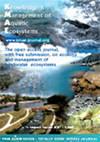绿藻对富营养化敏感性的变化影响其营养和生态状态指示的潜力
IF 1.7
3区 环境科学与生态学
Q3 FISHERIES
引用次数: 4
摘要
蕨草(石草)是一组对富营养化敏感的大型植物。蕨类植物对富营养化具有很高的指示价值,因此在生物评价系统中得到了广泛的应用。我探索了低温带湖泊中石草群落对营养条件需求的变异性,并试图确定单个句法类群在评估波兰湖泊生态状况中的作用。采用离心力平均指数法分析了蕨类植物群落生态位在营养梯度上的位置。一些石草群落,即Nitelletum opacae、N. mucronatae、N. flexilis和Charetum filiformis似乎对水质有专门的关注,可能被认为是生境富营养化程度低于研究领域“平均”营养条件的指标。大多数石草群落在欧洲水域相对普遍。其中4种可归为“通才”,边际性低,生态耐受性广,分别为毛囊菌(Charetum tomentosae)、asperae、C. contrariae和Nitellopsidetum obtusae。大多数石草群落出现在广泛的生态状态等级中。在15个群落中,6 - 25%的病例发生在状况不佳的湖泊中,不能视为良好生态条件的标志。而在石草植物群落存在的情况下,最有可能出现较高的分类多样性和广泛的植物群落带。在多栖物种栖息的低地富营养化湖泊中,蕨类植物在生态状况评估中的重要作用可以通过它们对沿岸发展的重要贡献来解释。本文章由计算机程序翻译,如有差异,请以英文原文为准。
Charophyte variation in sensitivity to eutrophication affects their potential for the trophic and ecological status indication
Charophytes (stoneworts) form a group of macrophytes that are considered sensitive to eutrophication. The high indicator value of charophytes toward eutrophication results in their wide use in the bioassessment systems. I explored the variability of stonewort communities' requirements for trophic conditions in lowland temperate lakes and attempted to determine the role of individual syntaxa in assessing the ecological status of lakes in Poland. The position of charophyte communities' niches along the trophic gradient was analysed using the Outlying Mean Index approach. A few stonewort communities, i.e., Nitelletum opacae, N. mucronatae, N. flexilis and Charetum filiformis appeared to be specialised concerning water quality and may be considered indicators of habitats less eutrophic than the “mean” trophic conditions in the study domain. Most stonewort communities were relatively common in European waters. Four of them, i.e., Charetum tomentosae, C. asperae, C. contrariae and Nitellopsidetum obtusae, can be classified as ‘generalists’ with low marginality and broad ecological tolerance. Most stonewort communities appeared in a broad range of ecological status classes. In the case of 15 communities, 6 to 25% of occurrences were observed in lakes representing a less than good status, and they cannot be considered indicative of good ecological conditions. However, the high taxonomic diversity and extensive phytolittoral zone were most likely to occur when the phytocoenoses of stoneworts were present. In lowland naturally eutrophic lakes inhabited by eurytopic species, the extraordinary role of charophytes in the assessment of the ecological status can be interpreted through their significant contribution to the development of the littoral.
求助全文
通过发布文献求助,成功后即可免费获取论文全文。
去求助
来源期刊

Knowledge and Management of Aquatic Ecosystems
环境科学-海洋与淡水生物学
CiteScore
3.70
自引率
5.60%
发文量
22
审稿时长
>12 weeks
期刊介绍:
Knowledge and Management of Aquatic Ecosystems (KMAE-Bulletin Français de la Pêche et de la Pisciculture since 1928) serves as a foundation for scientific advice across the broad spectrum of management and conservation issues related to freshwater ecosystems.
The journal publishes articles, short communications, reviews, comments and replies that contribute to a scientific understanding of freshwater ecosystems and the impact of human activities upon these systems. Its scope includes economic, social, and public administration studies, in so far as they are directly concerned with the management of freshwater ecosystems (e.g. European Water Framework Directive, USA Clean Water Act, Canadian Water Quality Guidelines, …) and prove of general interest to freshwater specialists. Papers on insular freshwater ecosystems and on transitional waters are welcome. KMAE is not a preferred journal for taxonomical, physiological, biological, toxicological studies, unless a clear link to ecological aspects can be established. Articles with a very descriptive content can be accepted if they are part of a broader ecological context.
 求助内容:
求助内容: 应助结果提醒方式:
应助结果提醒方式:


